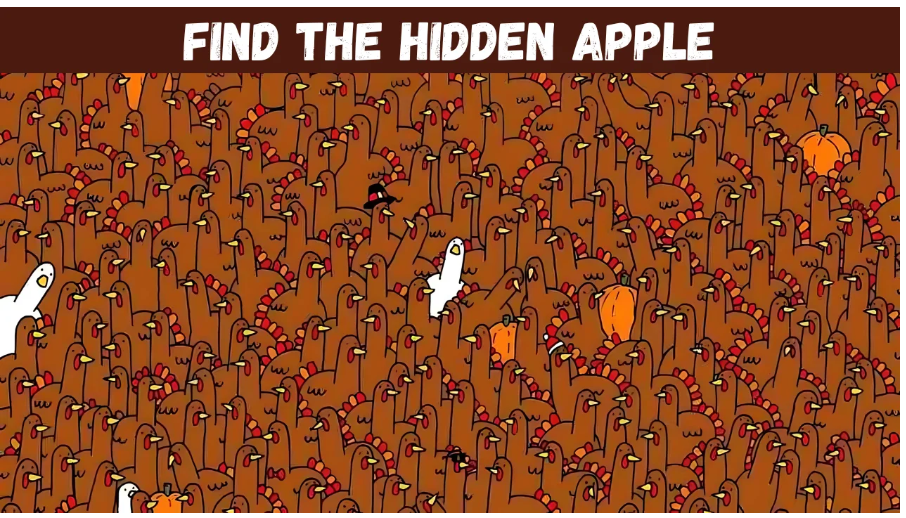Have you ever come across a challenge that has your brain twisting and turning, caught in a delightful web of confusion? Enter the realm of optical illusions, where perception takes center stage and reality can do a little cha-cha. Today, we’re diving deep into the fascinating world of the “Optical Illusion IQ Test: Can You Spot the Hidden Apple in 5 Seconds?” Sounds like a piece of cake, right? Or is it? Let’s explore this intriguing puzzle and see what it reveals about our cognitive abilities.
What is an Optical Illusion?
At its core, an optical illusion tricks our eyes and brain into seeing something that might not be there or at least is perceived differently than it exists. It’s like a magic show — just when you think you’ve got it figured out, the trickster pulls the rug from beneath you. These illusions can manifest in various forms — from static images that seem to move to hidden shapes camouflaged within an image. They’re not just fun brain teasers; they offer a fascinating insight into how our brains interpret visual information.
The Challenge: Spotting the Hidden Apple
So, here’s the scoop: the optical illusion IQ test we’re discussing challenges you to find a hidden apple among a bustling scene, like finding that one unique sock in a sea of laundry. The twist? You’ve got a mere five seconds to make the discovery. It’s both thrilling and maddening, isn’t it? Your heart races as you scan the image, your mind racing even faster, asking, “Where could that sneaky apple be hiding?”
Why Do Optical Illusions Matter?
You might wonder why something as seemingly simple as spotting an apple is significant. Well, these tests can serve as a gauge of our cognitive abilities, including focus, attention to detail, and pattern recognition. Each optical illusion tells a story about how we process information. Are you quick to find the apple, or do you struggle under pressure? This simple exercise can spark a reflection on how we approach challenges in life.
The Psychology Behind Optical Illusions
Let’s get a bit nerdy and peel back the layers of psychology. Our brains rely on previous experiences and context to interpret what we see. In the apple puzzle, the surrounding elements are designed to distract you, leading your brain down a winding path, full of twists and turns. It’s almost like when you’re trying to remember where you put your keys; sometimes, your own brain becomes the villain in the story!
Tips to Spot the Hidden Apple Quickly
As with any challenge, a little strategy goes a long way. Here are some nifty tips that could help you bolt past that apple in no time:
- **Focus Your Vision:** Try to look at the image as a whole rather than fixating on any single element.
- **Scan Methodically:** Have a systematic approach. For instance, move your eyes left to right and then top to bottom.
- **Reduce Distractions:** Minimizing surrounding distractions can help center your attention on the task at hand.
The Fun Aspect of IQ Tests with Optical Illusions
One of the best parts about optical illusion IQ tests is how they bridge the gap between entertainment and education. They compel us to use our brains while offering a light-hearted challenge. It’s the perfect excuse to gather your friends and see who can uncover the elusive apple the fastest. Who doesn’t love a little friendly competition?
Conclusion
Optical illusions are not just quirky visuals; they are intricate mental games that unveil our cognitive strengths and weaknesses. When faced with the optical illusion IQ test, “Can You Spot the Hidden Apple in 5 Seconds?” we discover a little more not just about our ability to spot things but also about the wonderful complexities of our minds. So, the next time you stumble upon an illusion, embrace the challenge, have some fun, and perhaps even share the experience with someone else!
FAQs
1. What is an optical illusion?
An optical illusion is a visual perception that deviates from reality, making objects appear different than they are, often leading to confusion.
2. Why is spotting the hidden apple significant?
It challenges cognitive functions like attention, focus, and pattern recognition, giving insights into how our brains process visual information.
3. How can I improve my chances of spotting the apple quickly?
Focus your vision, scan methodically, and minimize distractions to enhance your ability to spot the apple swiftly.
4. Are optical illusions only for entertainment?
While they are fun, optical illusions also serve educational purposes by revealing how our perception works.
5. Can anyone spot the hidden apple?
Yes, with practice and the right techniques, anyone can improve their skills in spotting hidden objects, including apples!

